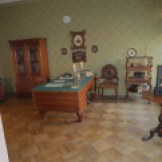We spent our last day in St Petersburg at the Dostoyevsky Museum.
Like some of the other tours we’ve attended, the tour consists of transport provided by the tour company and the services of an interpreter who translates for the local guide. It was like this at the Tolstoy and Chekhov estates and although I suppose it’s possible to go independently, (which may be cheaper) it has been a real pleasure to hear from local guides who are experts on their topics and have a passion for their work.
So it was today where the local guide enthused about Dostoyevsky, so much so that the interpreter apologised afterwards for not quite keeping up with her, but we didn’t mind at all. It was a great experience to go through his house – one of many that he lived in, but this is the one that he wrote The Brothers Karamazov in, and the one that he died in, aged only 59.
The house had been subdivided during ‘Soviet Times’ (as locals call the era) but it has now been restored to the way that it would have been during Dostoyevsky’s lifetime. They peeled off 20 layers of wallpaper and then made reproductions of the original, and they have decorated it with authentic furniture, including the author’s own desk, the one where he was working when he died.
In the children’s bedroom you can see a poignant little note from his son, and also a rocking horse – Dostoyevsky was devastated by the deaths of two of his children: his daughter Sofia died when an infant, and his son Aleksei died of epilepsy when only three.
In the study of his second wife Anna you can see her account books and her abacus where she kept meticulous records of their money. Despite his fame, the family was often in debt, partly because he was a gambler but also because he had spent time in prison due to the political nature of his works. (Apparently Anna’s family was none too keen on the marriage because he was disreputable, but she was crazy about him so they married anyway).
There are family photographs on the walls, and in the reception room there are photos of the notables who came to visit Dostoyevsky once he became famous. I thought it was rather sad that in the last home of an author who died of lung disease, they have kept his last packet of tobacco on display under a glass case.
There is also an exhibition of photos and facsimiles of his manuscripts, and of course, a monument outside!
Update: November 2013
I’m still scrapbooking this trip, and I’ve realised that I skipped a whole day of the tour.
It was the day we went to the Yuspov Palace, and had lunch at the Renaissance Hotel afterwards.
The Yusopov Palace is, apparently, one of 57 palaces owned by the Yusopovs but it was Felix Yusopov’s favourite. It features a theatre, because it wasn’t respectable for princesses to attend the theatre, so they built one in-house. The palace is famous for being the site of Rasputin’s murder, a bizarre tale, which you can read about at Wikipedia.
This slideshow requires JavaScript.
 After that we took a walk and ended up at the Benois Wing of the ‘Russian Museum’, which is mostly 20th century Russian Art. Here’s a link to a virtual tour of it.
After that we took a walk and ended up at the Benois Wing of the ‘Russian Museum’, which is mostly 20th century Russian Art. Here’s a link to a virtual tour of it.
And we had dinner at the Vodka Museum, which has over 200 different kinds of vodka to try, which may be why I didn’t get round to writing about the day …
 Here I am outside the house, all excited by the Bookish Moment. (And impressed that a taxi slowed down so that his vehicle wouldn’t block Tim taking a photo from the other side of the road!)
Here I am outside the house, all excited by the Bookish Moment. (And impressed that a taxi slowed down so that his vehicle wouldn’t block Tim taking a photo from the other side of the road!)










